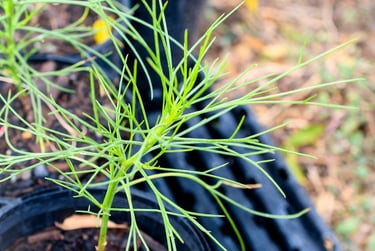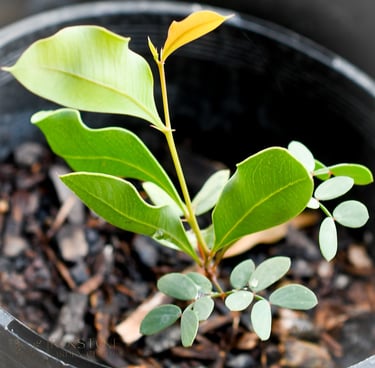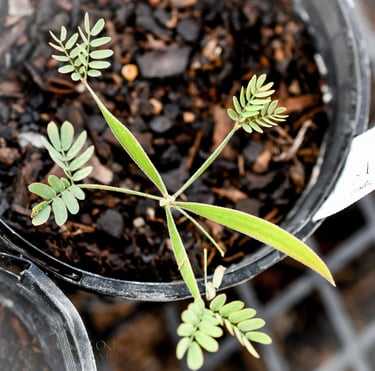How heteroblasty helps us select species for survival in Winton


Arid climates pose unique challenges for gardeners and plant enthusiasts due to scarce water, temperature swings, and harsh conditions. In semi-arid places like Winton, these challenges are especially significant and influence which plants can thrive there.
Heteroblastic adaptation is crucial for choosing plants that can survive and flourish in arid environments like Winton. This adaptation indicates a plant's suitability for semi-arid climates for several reasons:
Heteroblastic plants shift from larger, water-hungry juvenile leaves to smaller, water-saving adult leaves or phyllodes. This helps them reduce water loss through transpiration.
These plants adjust leaf shapes to manage temperature effectively. Bigger juvenile leaves maximise photosynthesis in cooler times, while smaller adult leaves or phyllodes prevent heat stress during hot spells, which is critical in climates with big temperature swings.
Tougher adult leaves or modified structures deter herbivores, helping plants survive in areas with higher grazing pressure.
Juvenile leaves focus on photosynthesis and energy capture, while adult leaves or phyllodes prioritise resource conservation, vital in semi-arid regions with limited resources.
Heteroblastic adaptations are key survival strategies for plants in arid and semi-arid climates. The presence of heteroblasty suggests that plants have evolved to cope with challenges in such conditions.
In the following photographs, you can identify younger or newer leaves on a sapling by observing that they're typically closer to the tips of branches or shoots. As the leaves age, they move further down the branch or stem.
Alyogyne hakeifolia
This plant demonstrates remarkable heteroblastic adaptation through its juvenile and adult leaves. In its juvenile stage, Alyogyne hakeifolia has narrow, deeply lobed leaves resembling ferns, capitalising on photosynthesis.
As it matures, Alyogyne hakeifolia transforms into its adult form with slender, needle-like leaves that reduce water loss and maximise resource utilisation, contributing significantly to growth and energy production.


Acacia inaequilatera
This species showcases distinct heteroblastic patterns in leaf morphology. In its juvenile stage, it produces compound leaves with more leaflets for efficient photosynthesis. Features like fine hairs protect against herbivores and environmental stress.
As Acacia inaequilatera matures, it develops phyllodes, modified leaf structures resembling flattened or elongated stems. They serve the function of photosynthesis, similar to leaves in other plants. Adult phyllodes are often broader and less complex than juvenile leaves, with fewer leaflets or none. The transition to phyllodes in adulthood represents an adaptation to arid environments, helping reduce water loss through transpiration.




Acacia binervia
This species exhibits unique heteroblastic changes in leaf morphology. This species typically produces bipinnate compound juvenile leaves consisting of pairs of leaflets arranged along a central axis, with each leaflet further divided into smaller segments. The intricate structure maximises surface area for photosynthesis and aids in capturing sunlight efficiently during the plant's early growth phase.
As Acacia binervia matures, it transitions to its adult form. It is characterised by developing phyllodes that are typically flattened and elongated, with fewer leaflets or none. They may have a single prominent midrib or vein running along their length. Phyllodes help reduce water loss through transpiration, as they have fewer stomata (tiny pores on plant surfaces) and a reduced surface area than compound leaves.
Heteroblastic adaptation is more common in plants from arid or semi-arid climates due to its multiple benefits. Heteroblastic plants conserve water efficiently, a critical factor in arid and semi-arid regions like Winton, and heteroblastic changes aid in temperature regulation, essential for plant survival in climates with wide temperature fluctuations. Transitioning to tougher leaf structures deters herbivores, protecting plants' photosynthetic organs in grazed environments. Heteroblastic adaptation optimises resource use based on growth stages, enhancing plant resilience in water-stressed environments.
Heteroblastic adaptation is a fascinating aspect of plant biology that plays a crucial role in plant survival and resilience in arid climates like Winton. Understanding heteroblasty helps us here at Ironstone Garden Centre select and cultivate species well-suited to thrive in challenging environmental conditions, contributing to sustainable and vibrant gardens in arid regions.
